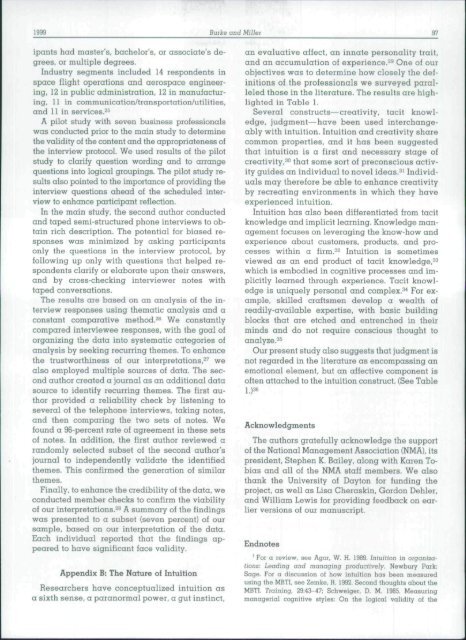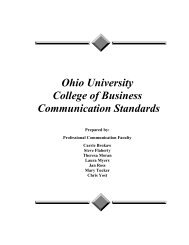Taking the mystery out of intuitive decision making
Taking the mystery out of intuitive decision making
Taking the mystery out of intuitive decision making
Create successful ePaper yourself
Turn your PDF publications into a flip-book with our unique Google optimized e-Paper software.
1999 Buike and Miller 97<br />
ipants had master's, bachelor's, or associate's degrees,<br />
or multiple degrees.<br />
Industry segments included 14 respondents in<br />
space flight operations and aerospace engineering,<br />
12 in public administration, 12 in manufacturing,<br />
11 in communication/transportation/utilities,<br />
and 11 in services.^^<br />
A pilot study with seven business pr<strong>of</strong>essionals<br />
was conducted prior to <strong>the</strong> main study to determine<br />
<strong>the</strong> validity <strong>of</strong> <strong>the</strong> content and <strong>the</strong> appropriateness <strong>of</strong><br />
<strong>the</strong> interview protocol. We used results <strong>of</strong> <strong>the</strong> pilot<br />
study to clarify question wording and to arrange<br />
questions into logical groupings. The pilot study results<br />
also pointed to <strong>the</strong> importance <strong>of</strong> providing <strong>the</strong><br />
interview questions ahead <strong>of</strong> <strong>the</strong> scheduled interview<br />
to enhance participant reflection.<br />
In <strong>the</strong> main study, <strong>the</strong> second author conducted<br />
and taped semi-structured phone interviews to obtain<br />
rich description. The potential for biased responses<br />
was minimized by asking participants<br />
only <strong>the</strong> questions in <strong>the</strong> interview protocol, by<br />
following up only with questions that helped respondents<br />
clarify or elaborate upon <strong>the</strong>ir answers,<br />
and by cross-checking interviewer notes with<br />
taped conversations.<br />
The results are based on an analysis <strong>of</strong> <strong>the</strong> interview<br />
responses using <strong>the</strong>matic analysis and a<br />
constant comparative method.^^ We constantly<br />
compared interviewee responses, with <strong>the</strong> goal <strong>of</strong><br />
organizing <strong>the</strong> data into systematic categories <strong>of</strong><br />
analysis by seeking recurring <strong>the</strong>mes. To enhance<br />
<strong>the</strong> trustworthiness <strong>of</strong> our interpretations,^^ we<br />
also employed multiple sources <strong>of</strong> data. The second<br />
author created a journal as an additional data<br />
source to identify recurring <strong>the</strong>mes. The first author<br />
provided a reliability check by listening to<br />
several <strong>of</strong> <strong>the</strong> telephone interviews, taking notes,<br />
and <strong>the</strong>n comparing <strong>the</strong> two sets <strong>of</strong> notes. We<br />
found a 96-percent rate <strong>of</strong> agreement in <strong>the</strong>se sets<br />
<strong>of</strong> notes. In addition, <strong>the</strong> first author reviewed a<br />
randomly selected subset <strong>of</strong> <strong>the</strong> second author's<br />
journal to independently validate <strong>the</strong> identified<br />
<strong>the</strong>mes. This confirmed <strong>the</strong> generation <strong>of</strong> similar<br />
<strong>the</strong>mes.<br />
Finally, to enhance <strong>the</strong> credibility <strong>of</strong> <strong>the</strong> data, we<br />
conducted member checks to confirm <strong>the</strong> viability<br />
<strong>of</strong> our interpretations.28 A summary <strong>of</strong> <strong>the</strong> findings<br />
was presented to a subset (seven percent) <strong>of</strong> our<br />
sample, based on our interpretation <strong>of</strong> <strong>the</strong> data.<br />
Each individual reported that <strong>the</strong> findings appeared<br />
to have significant face validity.<br />
Appendix B: The Nature <strong>of</strong> Intuition<br />
Researchers have conceptualized intuition as<br />
a sixth sense, a paranormal power, a gut instinct.<br />
an evaluative affect, an innate personality trait,<br />
and an accumulation <strong>of</strong> experience.^^ One <strong>of</strong> our<br />
objectives was to determine how closely <strong>the</strong> definitions<br />
<strong>of</strong> <strong>the</strong> pr<strong>of</strong>essionals we surveyed paralleled<br />
those in <strong>the</strong> literature. The results are highlighted<br />
in Table 1.<br />
Several constructs—creativity, tacit knowledge,<br />
judgment—have been used interchangeably<br />
with intuition. Intuition and creativity share<br />
common properties, and it has been suggested<br />
that intuition is a first and necessary stage <strong>of</strong><br />
creativity,^'^ that some sort <strong>of</strong> preconscious activity<br />
guides an individual to novel ideas.^' Individuals<br />
may <strong>the</strong>refore be able to enhance creativity<br />
by recreating environments in which <strong>the</strong>y have<br />
experienced intuition.<br />
Intuition has also been differentiated from tacit<br />
knowledge and implicit learning. Knowledge management<br />
focuses on leveraging <strong>the</strong> know-how and<br />
experience ab<strong>out</strong> customers, products, and processes<br />
within a firm.2^- Intuition is sometimes<br />
viewed as an end product <strong>of</strong> tacit knowledge,^^<br />
which is embodied in cognitive processes and implicitly<br />
learned through experience. Tacit knowledge<br />
is uniquely personal and complex.3" For example,<br />
skilled craftsmen develop a wealth <strong>of</strong><br />
readily-available expertise, with basic building<br />
blocks that are etched and entrenched in <strong>the</strong>ir<br />
minds and do not require conscious thought to<br />
analyze.3^<br />
Our present study also suggests that judgment is<br />
not regarded in <strong>the</strong> literature as encompassing an<br />
emotional element, but an affective component is<br />
<strong>of</strong>ten attached to <strong>the</strong> intuition construct. (See Table<br />
Acknowledgments<br />
The authors gratefully acknowledge <strong>the</strong> support<br />
<strong>of</strong> <strong>the</strong> National Management Association (NMA), its<br />
president, Stephen K. Bailey, along with Karen Tobias<br />
and all <strong>of</strong> <strong>the</strong> NMA staff members. We also<br />
thank <strong>the</strong> University <strong>of</strong> Dayton for funding <strong>the</strong><br />
project, as well as Lisa Cheraskin, Gordon Dehler,<br />
and William Lewis for providing feedback on earlier<br />
versions <strong>of</strong> our manuscript.<br />
Endnotes<br />
' For a review, see Agor, W. H. 1989, Intuition in organizations:<br />
Leading and managing productively. Newbury Park:<br />
Sage. For a discussion <strong>of</strong> how intuition has been measured<br />
using <strong>the</strong> MBTI, see Zemke, R. 1992. Second thoughts ab<strong>out</strong> <strong>the</strong><br />
MBTl. Training. 29:43-47; Schweiger, D. M. 1985. Measuring<br />
managerial cognitive styles: On <strong>the</strong> logical validity <strong>of</strong> <strong>the</strong>




